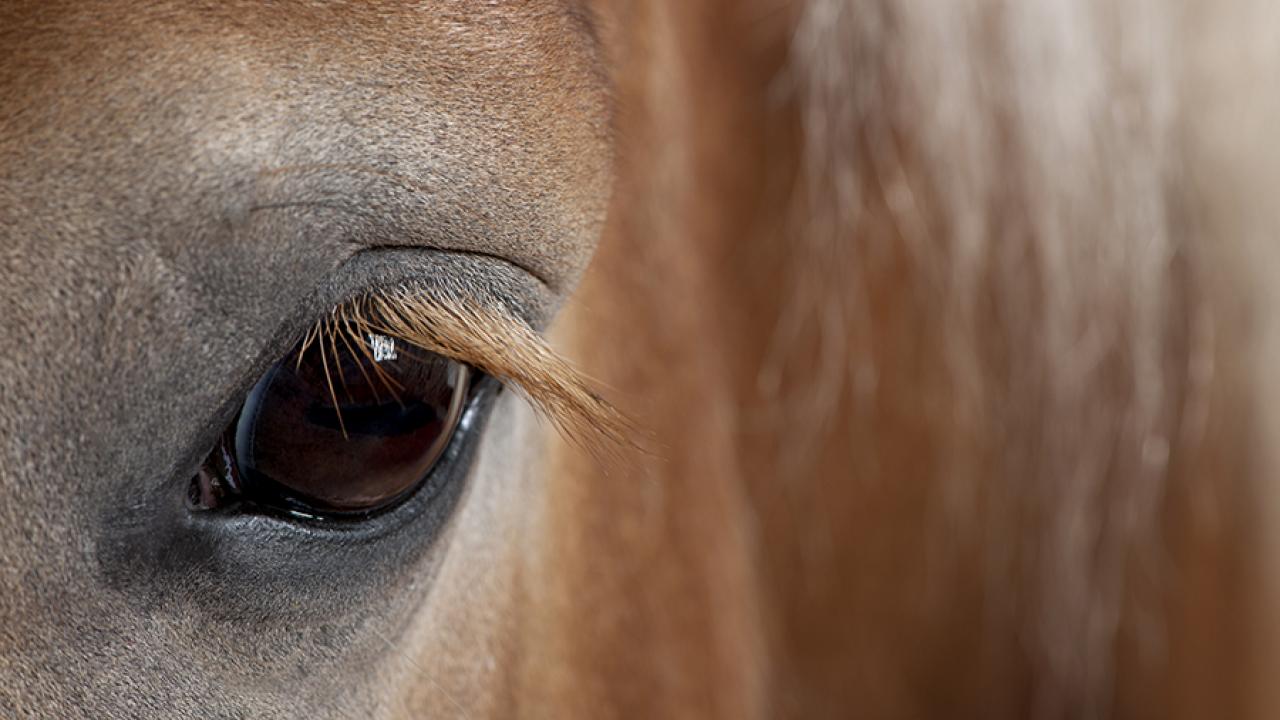
Ocular Squamous Cell Carcinoma in Belgian Horses
Background: Squamous cell carcinoma (SCC) is the second most common type of cancer in horses and the most frequent cancer affecting the equine eye. Among reported cases, Haflingers and Belgians have a higher incidence of SCC of both the limbus and the third eyelid, which suggests that genetic factors play a role in these two breeds. Earlier research at the Veterinary Genetics Laboratory identified a variant in the UV damage DNA repair gene Damage-specific DNA Binding Protein 2 (DDB2) that was strongly associated with cancer risk in Haflingers. This missense mutation (DDB2 c.1013C>T, p.Thr338Met), inherited as an autosomal recessive trait, is a genetic risk factor for ocular SCC in Haflingers: Haflingers homozygous (R/R) for the risk variant were shown to be 5.6 times more likely to develop ocular SCC than those horses with one copy (R/N) or no copies (N/N) of the risk factor.
The research: A new study by researchers at the Veterinary Genetics Laboratory investigated the occurrence of ocular SCC in the Belgian breed to determine if the mutation associated with ocular SCC in Haflingers (DDB2 c.1013C>T) is a risk factor for the same condition in Belgian horses.
The results: The DDB2 c.1013C>T mutation was significantly associated with ocular SCC in Belgian horses. Belgian horses homozygous for the risk factor (R/R) were 4.0 times more likely to develop ocular SCC than horses with one copy (R/N) or no copies (N/N) of the risk factor.
This work confirms that the DDB2 mutation explains risk for ocular SCC in some horses and this DNA test can be used for breeding and clinical management decisions in both the Belgian and Haflinger breeds. More work is needed to investigate the link with ocular cancer in other horse breeds.
References:
Lassaline, M., Cranford, T. L., Latimer, C. A., & Bellone, R. (2015) Limbal squamous cell carcinoma in Haflinger horses. Veterinary Ophthalmology, 18(5), 404-408. doi: 10.1111/vop.12229
Bellone, R. R., Liu, J., Petersen, J. L., Mack, M., Singer-Berk, M., Drögemüller, C., Malvick, J., Wallner, B., Brem, G., Penedo, M. C., & Lassaline, M. (2017). A Missense Mutation in Damage-specific DNA Binding Protein 2 Is a Genetic Risk Factor for Limbal Squamous Cell Carcinoma in Horses. International Journal of Cancer, 141(2), 342-353. doi: 10.1002/ijc.30744
Singer‐Berk, M., Knickelbein, K. E., Vig, S., Liu, J., Bentley, E., Nunnery, C., Reilly, C., Dwyer, A., Drögemüller, C., Unger, L., Gerber, V., Lassaline, M., & Bellone, R.R. (2018). Genetic risk for squamous cell carcinoma of the nictitating membrane parallels that of the limbus in Haflinger horses. Animal Genetics, 49(5), 457-460. doi: 10.1111/age.12695
Knickelbein, K. E., Lassaline, M. E., & Bellone, R. R. (2018). Limbal squamous cell carcinoma in a Rocky Mountain Horse: Case report and investigation of genetic contribution. Veterinary Ophthalmology, 22(2), 1–5. doi: 10.1111/vop.12612
Knickelbein, K. E., Lassaline, M. E., Singer‐Berk, M., Reilly, C. M., Clode, A. B., Famula, T. R., Michau T.M., & Bellone, R. R. (2019). A missense mutation in damage‐specific DNA binding protein 2 is a genetic risk factor for ocular squamous cell carcinoma in Belgian horses. Equine Veterinary Journal. doi: 10.1111/evj.13116



